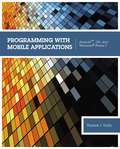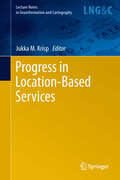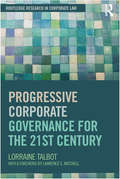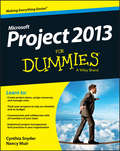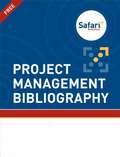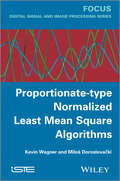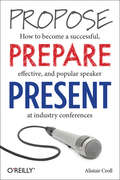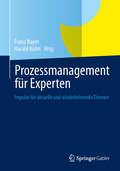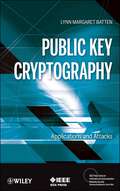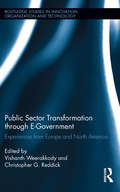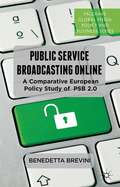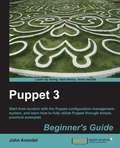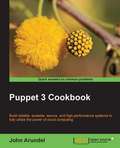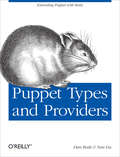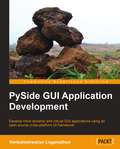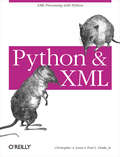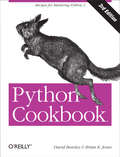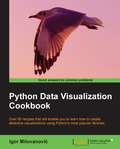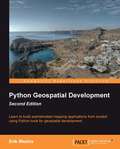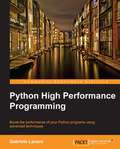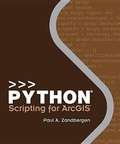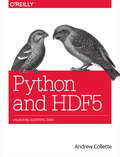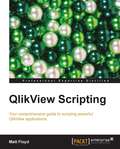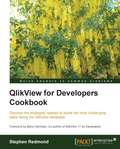- Table View
- List View
Programming with Mobile Applications: Android, iOS, and Windows® Phone 7
by Thomas J. DuffyDiscover how to create effective native apps across platforms and Web apps for today's most popular smartphone platforms with Duffy's PROGRAMMING MOBILE APPLICATIONS: ANDROID(tm), iOS, AND WINDOWS PHONE 7. This unique, hands-on tutorial approach combines clear presentations with numerous screenshots and step-by-step instructions to guide readers in developing applications for Google(tm) Android(tm), Apple iOS, and Windows Phone 7. Readers learn to create identical native and Web apps for each platform, which allows comparing each platform's development processes. The book's complete coverage ranges from platform architecture to native app life cycle management with an emphasis on fundamental programming concepts. This book's unique coverage of multiple platforms not only demonstrates the portability of apps that readers create, but also ensures an solid understanding of programming principles that benefits readers throughout any career.
Progress in Location-Based Services
by Jukka M. KrispThe book consists of peer-reviewed papers from the 9th symposium on Location Based Services (LBS) which is targeted to researchers, industry/market operators and students of different backgrounds (scientific, engineering and humanistic). As the research field is developing and changing fast, this book follows up on current trends and gives suggestions and guidance to further research. This book offers a common ground bringing together various disciplines and practice, knowledge, experiences, plans and ideas on how LBS can and could be improved and on how it will influence both science and society. The book comprises front-end publications organized into sections on: spatial-temporal data acquisition, processing & analysis; positioning / indoor positioning; way-finding / navigation (indoor / outdoor) & smart mobile phone navigation; interactions, user studies and evaluations; innovative LBS systems & applications.
Progressive Corporate Governance for the 21st Century (Routledge Research in Corporate Law)
by Lorraine TalbotProgressive Corporate Governance for the 21st Century is a wide ranging and ambitious study of why corporate governance is the shape that it is, and how it can be better. The book sets out the emergence of shareholder primacy orientated corporate governance using a study of historical developments in the United Kingdom and the United States. Talbot sees shareholder primacy as a political choice made by governments, not a ‘natural’ feature of the inevitable market. She describes the periods of progressive corporate governance which governments promoted in the middle of the 20th century using a close examination of the theories of the company which then prevailed. She critically examines the rise of neoliberal theories on the company and corporate governance and argues that they have had a negative and regressive impact on social and economic development. In examining contemporary corporate governance she shows how regulatory styles as informed and described by prevailing regulatory theories, enables neoliberal outcomes. She illustrates how United Kingdom-derived corporate governance codes have informed the corporate governance initiatives of European and global institutions. From this she argues that neoliberalism has re-entered ex command transition economies through those United Kingdom and OECD inspired corporate governance Codes over a decade after the earlier failed and destructive neoliberal prescriptions for transition had been rejected. Throughout, Talbot argues that shareholder primacy has socially regressive outcomes and firmly takes a stand against current initiatives to enhance shareholder voting in such issues as director remuneration. The book concludes with a series of proposals to recalibrate the power between those involved in company activity; shareholders, directors and employees so that the public company can begin to work for the public and not shareholders.
Project 2013 For Dummies
by Cynthia Stackpole SnyderAn easy-to-understand guide to the?latest version of Microsoft's enterprise project management software: Project 2013If you've never used project management software before?or if?you're just getting up to speed on the new features in Project 2013, this is the book for you! With this easy-to-understand guide, you have a completely updated resource that covers the latest changes and newest enhancements to Project 2013 and shows you how to?make Project 2013 work for you. After an introduction to basic project management concepts, you'll discover the mechanics of using Project software to create and manage projects. Other topics covered include working with calendars, using and sharing resources, budgeting, formatting taskbars, gathering and tracking data, working with reports, and creating templates.Shows you how to manage resources, share project information, perform scenario analysis, and standardize reporting processesPresents completely updated coverage of the new Project 2013Reviews formatting taskbars, gathering and tracking data, and working with reportsAddresses using and sharing resources, creating templates, and managing projectsTake charge of your next project and ensure its success with a little help from Project 2013 For Dummies.
Project Management Bibliography
by Safari Content TeamProject Management is an integral part of businesses, reaching into most every industry, country and culture throughout the world. At its most basic level, Project Management is a set of principles, guidelines and tools used to manage work. It breaks down large units of work (i.e., feed the tribe) into more manageable sets of tasks (i.e., establish a hunting team, establish a gathering team, make and distribute tools, schedule the hunt, etc.). When these task sets are accomplished together, and in a specific order, the result is that the main unit of work is achieved. Project Management also consists of guidelines and tools used to monitor progress toward the main goal (i.e., How will a rain storm effect the scheduled hunt? Did the hunt start on time? Did we gather enough food for the week?). In this bibliography you will learn about basic, iterative and advanced Project Management techniques, the required tools to use, certification prep, useful toolkits and more. Whether you have just been thrown into Project Management without any formal training or instruction, or if you are a seasoned veteran of Project Management and already hold one or more certifications, this Project Management Bibliography is your guide to navigating the vast array of instructional media available on the topic, all of which you will find in Safari Books Online.
Proportionate-type Normalized Least Mean Square Algorithms
by Milos Doroslovacki Kevin WagnerThe topic of this book is proportionate-type normalized least mean squares (PtNLMS) adaptive filtering algorithms, which attempt to estimate an unknown impulse response by adaptively giving gains proportionate to an estimate of the impulse response and the current measured error. These algorithms offer low computational complexity and fast convergence times for sparse impulse responses in network and acoustic echo cancellation applications. New PtNLMS algorithms are developed by choosing gains that optimize user-defined criteria, such as mean square error, at all times. PtNLMS algorithms are extended from real-valued signals to complex-valued signals. The computational complexity of the presented algorithms is examined. Contents 1. Introduction to PtNLMS Algorithms2. LMS Analysis Techniques3. PtNLMS Analysis Techniques4. Algorithms Designed Based on Minimization of User Defined Criteria5. Probability Density of WD for PtLMS Algorithms6. Adaptive Step-size PtNLMS Algorithms7. Complex PtNLMS Algorithms8. Computational Complexity for PtNLMS Algorithms About the Authors Kevin Wagner has been a physicist with the Radar Division of the Naval Research Laboratory, Washington, DC, USA since 2001. His research interests are in the area of adaptive signal processing and non-convex optimization.Milos Doroslovacki has been with the Department of Electrical and Computer Engineering at George Washington University, USA since 1995, where he is now an Associate Professor. His main research interests are in the fields of adaptive signal processing, communication signals and systems, discrete-time signal and system theory, and wavelets and their applications.
Propose, Prepare, Present: How to become a successful, effective, and popular speaker at industry conferences
by Alistair CrollEvery year, tens of thousands of companies—from industry giants to aspiring upstarts—apply to speak at conferences. They pump millions of dollars into these events, hoping to find new customers, strengthen their brand, and meet new partners. Sadly, for most of them, things don’t go that way. Submitted topics aren’t chosen; when they are, they come across as tone-deaf sales pitches.What does it take to be chosen to speak—and to rock the mic when given the chance? This book takes you behind-the-scenes of the conference process, showing you how to submit, plan, and deliver a talk that matters. Event organizer Alistair Croll provides many examples based on his experience with a wide range of conferences, including O’Reilly’s Strata, Velocity, Web2Expo, and TOC Conferences.Learn 11 items that help your submission stand out—and 11 items that will get it tossedExplore the hurdles your proposal has to clear before it’s acceptedTailor your talk to a conference’s topics and themesDiscover why images work better than words in your slide deckAchieve your business goals by engaging the audience before, during, and after your talk"We’ve been running successful events worldwide for over a decade, and the simple truth is that the people who get chosen, and give great presentations, follow the rules in this book."--Gina Blaber, VP Conferences, O’Reilly Media
Prozessmanagement für Experten: Impulse für aktuelle und wiederkehrende Themen
by Franz Bayer Harald KühnDas Prozessmanagement mit seinen vielfältigen Aspekten ist mittlerweile in vielen Unternehmen ein fester Bestandteil der Organisationsgestaltung. Das vorliegende Buch liefert nicht nur Erläuterungen, "was" in den vorgestellten Facetten des Prozessmanagements getan werden soll, sondern auch konkrete Schritte, Empfehlungen und Beispiele, "wie" es effektiv und effizient umgesetzt werden kann. Im Buch sind Erfahrungen aus vielen Praxisjahren festgehalten, die es zu einem nützlichen Hilfsmittel und Impulsgeber machen. Die Autoren liefern Antworten auf Fragen, wie bspw. "Wie erstelle ich eine gute Prozesslandkarte?", "Wie identifiziere und etabliere ich die Prozessverantwortung für einen Prozess?", "Wie integriere ich Compliance-Anforderungen in das Prozessmanagement?" oder "Wie ermittle ich den Personalbedarf für einen bestimmten Prozess?". Über diese Gestaltungsfragen hinaus ist das Prozessmanagement heute in den Führungsebenen als Managementansatz angekommen. Auch in diesem Umfeld liefert das Werk einen hilfreichen Beitrag. Es zeigt, wie das Prozessmanagement mit anderen etablierten Managementansätzen zu einem sinnvollen Ganzen für eine umsichtige Planung, Umsetzung und Steuerung integriert werden kann. Die vorgestellten Themen sind insbesondere für Unternehmen bzw. Organisationen interessant, die in Bezug auf ihren umgesetzten Prozessmanagement-Ansatz einen mittleren bis höheren Reifegrad besitzen. Das Buch wurde mit der Zielsetzung zum Einsatz in der unternehmerischen Praxis geschrieben. Es kann darüber hinaus auch in der anwendungsorientierten Ausbildung zum Thema Prozessmanagement eingesetzt werden.
Public Key Cryptography
by Lynn Margaret BattenComplete coverage of the current major public key cryptosystems their underlying mathematics and the most common techniques used in attacking them Public Key Cryptography: Applications and Attacks introduces and explains the fundamentals of public key cryptography and explores its application in all major public key cryptosystems in current use, including ElGamal, RSA, Elliptic Curve, and digital signature schemes. <P><P>It provides the underlying mathematics needed to build and study these schemes as needed, and examines attacks on said schemes via the mathematical problems on which they are based - such as the discrete logarithm problem and the difficulty of factoring integers. The book contains approximately ten examples with detailed solutions, while each chapter includes forty to fifty problems with full solutions for odd-numbered problems provided in the Appendix. Public Key Cryptography: * Explains fundamentals of public key cryptography * Offers numerous examples and exercises * Provides excellent study tools for those preparing to take the Certified Information Systems Security Professional (CISSP) exam * Provides solutions to the end-of-chapter problems Public Key Cryptography provides a solid background for anyone who is employed by or seeking employment with a government organization, cloud service provider, or any large enterprise that uses public key systems to secure data.
Public Sector Transformation through E-Government: Experiences from Europe and North America (Routledge Studies in Innovation, Organizations and Technology)
by Christopher G. Reddick Vishanth WeerakkodyOver the last decade governments in Europe and North America have attempted to improve efficiency of public services through Information and Communication Technology, commonly branded as electronic government (e-government). Public Sector Transformation through E-Government explores the influence that e-government has on public sector organizations, the organizational complexities that result, and its impact on citizens and democratic society. This book examines e-government’s potential to transform public services from a theoretical perspective, and provides practical examples from leading public sector institutions that have utilized e-government as a basis to bring about change. It further investigates the relationship between citizens and government and how they are affected by e-government policies and programs. Aimed at students and researchers of public administration/management and information systems, this book serves as a welcome tool for examining and understanding e-government and transformational change.
Public Service Broadcasting Online
by Benedetta BreviniThis book investigates the extent to which a Public Service Broadcasting (PSB) ethos has been extended to the online world in Europe. It examines the most significant policy initiatives carried out by PSBs in Europe on online platforms, and analyzes how the public service philosophy is being reinvented by policy makers.
Puppet 3 Beginner’s Guide
by John ArundelPresented in an easy-to-follow, step-by-step tutorial format, Puppet 3.0 Beginner's Guide will lead you through the basics of setting up your Puppet server with plenty of screenshots and real-world solutions.This book is written for system administrators and developers, and anyone else who needs to manage computer systems. You will need to be able to edit text files and run a few commands on the command line, but otherwise no system administration or programming experience is required.
Puppet 3 Cookbook
by John ArundelPuppet 3 Cookbook is written in a Cookbook style, showing you how to set up and expand your Puppet infrastructure. It not only gives you everything you need to become a Puppet expert, but includes powerful code samples and techniques developed over many years of production experience. With it, you'll save time and effort by automating tedious manual processes, impress your boss by delivering better business value from IT, and future-proof your career by getting to grips with the new technologies revolutionizing the industry."Puppet 3 Cookbook" is for anyone who builds and administers servers, especially in a web operations context. It requires some experience of Linux systems administration, including familiarity with the command line, file system, and text editing. No programming experience is required.
Puppet Types and Providers: Extending Puppet with Ruby
by Nan Liu Dan BodePuppet’s true power exists in the simple resource model it uses to manage the state of complex operating systems. This concise guide shows you how to extend that model and implement custom functionality on top of Puppet by working with the type and provider APIs.Two experts from Puppet Labs explain the concepts behind these APIs, and provide instructions and examples to help you write your own fully functional types and providers. You’ll also delve into Puppet’s source code to get a better understanding of how types and providers are implemented internally. If you’re familiar with basic Puppet concepts, you’re ready to get started.Learn the fundamental concepts behind resources, and become familiar with the structure of Puppet’s Resource ModelDiscover how the type API is used to create new resource types that Puppet can manageUnderstand how providers interact with the system to achieve the desired state of a declared resourceExplore advanced features to get a more complete understanding of how Puppet worksSimplify the troubleshooting process when developing types and providers
PySide GUI Application Development
by Venkateshwaran LoganathanAn accessible and practical guide to developing GUI's for Python applications.This book is written for Python programmers who want to learn about GUI programming. It is also suitable for those who are new to Python but are familiar with object-oriented programming.
Python & XML: XML Processing with Python
by Christopher A. Jones Fred L. Drake JrIf you are a Python programmer who wants to incorporate XML into your skill set, this is the book for you. Python has attracted a wide variety of developers, who use it either as glue to connect critical programming tasks together, or as a complete cross-platform application development language. Yet, because it is object-oriented and has powerful text manipulation abilities, Python is an ideal language for manipulating XML.Python & XML gives you a solid foundation for using these two languages together. Loaded with practical examples, this new volume highlights common application tasks, so that you can learn by doing. The book starts with the basics then quickly progresses to complex topics, like transforming XML with XSLT, querying XML with XPath, and working with XML dialects and validation. It also explores the more advanced issues: using Python with SOAP and distributed web services, and using Python to create scalable streams between distributed applications (like databases and web servers).The book provides effective practical applications, while referencing many of the tools involved in XML processing and Python, and highlights cross-platform issues along with tasks relevant to enterprise computing. You will find ample coverage of XML flow analysis and details on ways in which you can transport XML through your network.Whether you are using Python as an application language, or as an administrative or middleware scripting language, you are sure to benefit from this book. If you want to use Python to manipulate XML, this is your guide.
Python Cookbook: Recipes for Mastering Python 3
by Brian K. Jones David BeazleyIf you need help writing programs in Python 3, or want to update older Python 2 code, this book is just the ticket. Packed with practical recipes written and tested with Python 3.3, this unique cookbook is for experienced Python programmers who want to focus on modern tools and idioms.Inside, youâ??ll find complete recipes for more than a dozen topics, covering the core Python language as well as tasks common to a wide variety of application domains. Each recipe contains code samples you can use in your projects right away, along with a discussion about how and why the solution works.Topics include:Data Structures and AlgorithmsStrings and TextNumbers, Dates, and TimesIterators and GeneratorsFiles and I/OData Encoding and ProcessingFunctionsClasses and ObjectsMetaprogrammingModules and PackagesNetwork and Web ProgrammingConcurrencyUtility Scripting and System AdministrationTesting, Debugging, and ExceptionsC Extensions
Python Data Visualization Cookbook
by Igor MilovanovicThis book is written in a Cookbook style targeted towards an advanced audience. It covers the advanced topics of data visualization in Python.Python Data Visualization Cookbook is for developers that already know about Python programming in general. If you have heard about data visualization but you don't know where to start, then this book will guide you from the start and help you understand data, data formats, data visualization, and how to use Python to visualize data.You will need to know some general programming concepts, and any kind of programming experience will be helpful, but the code in this book is explained almost line by line. You don't need maths for this book, every concept that is introduced is thoroughly explained in plain English, and references are available for further interest in the topic.
Python Geospatial Development, Second Edition
by Erik WestraThis is a tutorial style book that will teach usage of Python tools for GIS using simple practical examples and then show you how to build a complete mapping application from scratch. The book assumes basic knowledge of Python. No knowledge of Open Source GIS is required.Experienced Python developers who want to learn about geospatial concepts, work with geospatial data, solve spatial problems, and build map-based applications.This book will be useful those who want to get up to speed with Open Source GIS in order to build GIS applications or integrate Geo-Spatial features into their existing applications.
Python High Performance Programming
by Gabriele LanaroAn exciting, easy-to-follow guide illustrating the techniques to boost the performance of Python code, and their applications with plenty of hands-on examples.If you are a programmer who likes the power and simplicity of Python and would like to use this language for performance-critical applications, this book is ideal for you. All that is required is a basic knowledge of the Python programming language. The book will cover basic and advanced topics so will be great for you whether you are a new or a seasoned Python developer.
Python Scripting For ArcGIS
by Paul A. ZandbergenThis book is a guide for experienced users of ArcGIS® Desktop to get started with Python scripting without needing previous programming experience. Experience with other scripting or programming languages (Perl, VBA, VB script, Java, C++) is helpful but not required. Readers are expected to have good general ArcGIS skills and a basic understanding of geoprocessing procedures.
Python and HDF5: Unlocking Scientific Data
by Andrew ColletteGain hands-on experience with HDF5 for storing scientific data in Python. This practical guide quickly gets you up to speed on the details, best practices, and pitfalls of using HDF5 to archive and share numerical datasets ranging in size from gigabytes to terabytes.Through real-world examples and practical exercises, you’ll explore topics such as scientific datasets, hierarchically organized groups, user-defined metadata, and interoperable files. Examples are applicable for users of both Python 2 and Python 3. If you’re familiar with the basics of Python data analysis, this is an ideal introduction to HDF5.Get set up with HDF5 tools and create your first HDF5 fileWork with datasets by learning the HDF5 Dataset objectUnderstand advanced features like dataset chunking and compressionLearn how to work with HDF5’s hierarchical structure, using groupsCreate self-describing files by adding metadata with HDF5 attributesTake advantage of HDF5’s type system to create interoperable filesExpress relationships among data with references, named types, and dimension scalesDiscover how Python mechanisms for writing parallel code interact with HDF5
QlikView 11 para Desarrolladores
by Miguel Angel Garcia Barry HarmsenEste libro va dirigido a desarrolladores y usuarios que quieren aprender a crear aplicaciones de Inteligencia de Negocios con QlikView. Desarrolladores que ya hayan usado QlikView por un tiempo podrán encontrar recomendaciones útiles y mejores prácticas para hacer uso más efectivo de QlikView. Este libro solamente cubre QlikView Desktop. Implementaciones en QlikView Server y Publisher estñan fuera del alcance de este libro. Este libro no va enfocado a administradores de servidores QlikView.
QlikView Scripting
by Matt FloydThis mini book offers information about QlikView scripting written in an easy-to-understand manner, and covers QlikView scripting from basic to advanced features in a compact format.If you are a basic orintermediate developer with some knowledge of QlikView applications and a basic understanding of QlikView scripting and data extraction and manipulation, this book will be great for you. If you are an advanced user, you can also use this book as a reference guide and teaching aid. If you are a QlikView project team member such as a business user, data/ETL professional, project manager, orsystems analyst, you can also benefit from gaining an understanding of the structure and the challenges of writing an efficient and useful QlikView application.
QlikView for Developers Cookbook
by Stephen RedmondThe recipes in this Cookbook provide a concise yet practical guide on how to become an excellent QlikView developer. The book begins with intermediate level recipes and then moves on to more complex recipes in an incremental manner.This book is for anyone who has either attended QlikView Developer training or has taught themselves QlikView from books or online sources. You might be working for a QlikView customer, partner, or even QlikView themselves (or want to!) and want to improve your QlikView skills.
